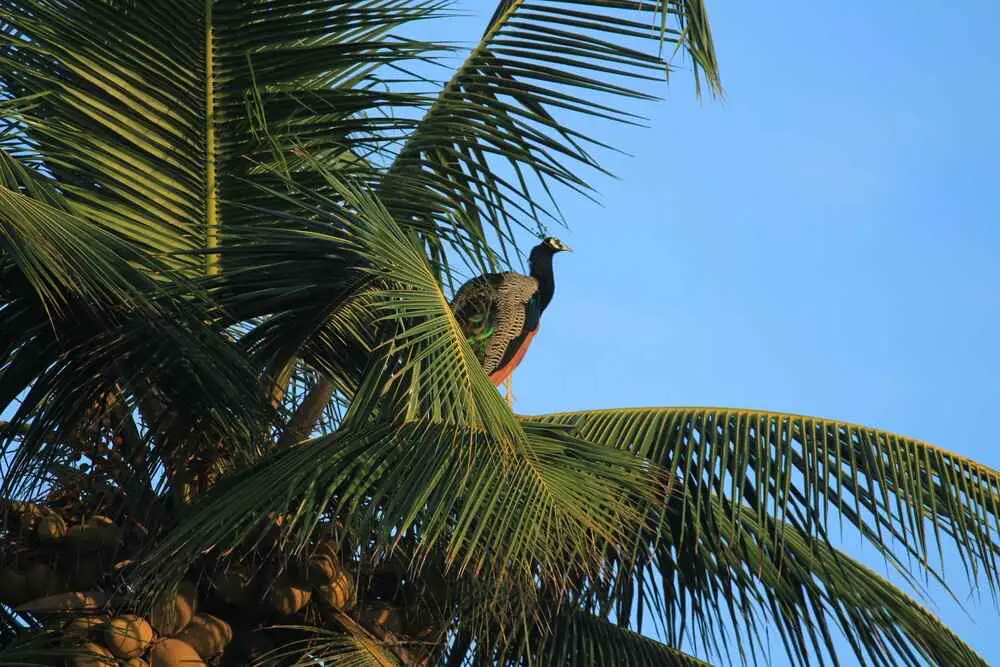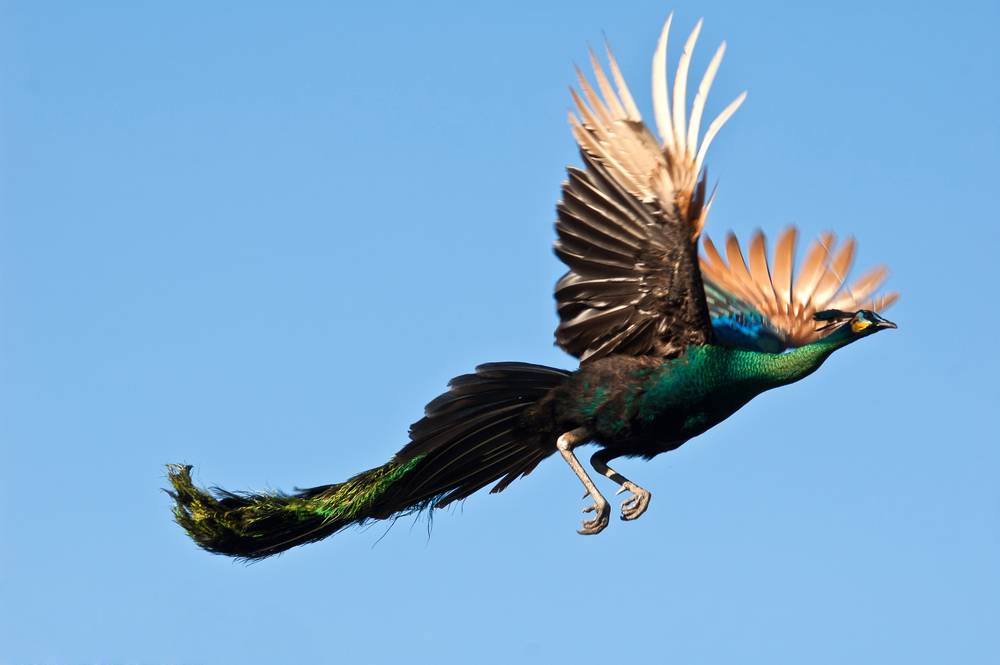Are you curious about the flight abilities of one of the most beautiful birds on the planet, the peacock? Well, you’ve come to the right place!
So, can peacocks fly? The answer is yes, they can fly, but not very far or very high. In fact, their flight abilities are quite limited compared to other birds.
But there’s still a lot to learn about these majestic creatures and their unique flying style.
If you’re interested in discovering just how far peacocks can fly, and why they can’t fly very high, then you’re in for a treat. Keep reading to find out more!.
Here’s How Far Peacocks Fly:
Peacocks are capable of short bursts of flight, usually to escape danger or reach a roosting spot. They can fly up to 100 m in one go and in total, they can fly 0.5 – 1 miles.
But it is essential to highlight that they don’t typically fly for long distances or for extended periods of time.
In their natural habitat, peacocks are usually found in forests and woodlands, where they roost in trees at night. They’ll often fly up to their roosting spot at dusk and fly down in the morning to forage for food on the ground.
So while they may not be soaring through the skies like an eagle, they’re still using their flying abilities to navigate their environment.
Flight Patterns Of Peacocks
Peacocks are easily distinguishable from other birds due to their distinctive flying style. Although they seldom go great distances in the air, when they do so it is very spectacular.
Peacocks only take to the air in the wild when threatened, crossing water, or heading to their nighttime roost.
A peacock’s ability to take flight is a remarkable demonstration of power. Even with their lengthy and heavy trains, they can propel themselves almost vertically into the air with a loud flap of wings.
As soon as they get into the air, they move swiftly and powerfully, navigating the forest canopy with twists and turns.
Their tail feathers stretch out in a spectacular show of color while they’re in flight. The male’s train feathers are coiled into a tight bundle to improve their aerodynamics and speed. Because of this, they are able to quickly and easily travel small distances in the air.
Peacocks can certainly fly, but they don’t use their wings very often and would much rather stroll or hop on the forest floor. They have powerful legs and can cover a lot of ground in a day, typically walking between three and four kilometers daily.
Interestingly, when they detect danger, they sprint as a pack, dodging obstacles and covering ground rather than taking to the air.
How High Can They Fly?

Peacocks typically fly about 8-10 feet off the ground. People have found them on tree branches that are almost more than 50-60 feet above the ground.
They can easily fly over the walls and fruit tree branches. I know, I know, all these may not be mind-blowing, but it gets the job done for them.
But hey, let’s give credit where credit’s due. When it comes to short bursts of speed and agility, peacocks are no slouches. They can fly up to 10 miles per hour, just enough to escape predators or leap into the trees for a good night’s sleep.
Peacocks might not be sky-high champions, but they can certainly spread their wings when it counts.
Why Can’t They Soar High?
Peacocks aren’t the high-flying birds of the sky. They have relatively small wings compared to their body size, making it difficult for them to soar or fly high.
Also, their long tail feathers can be cumbersome and limit their ability to maneuver while flying. Peacocks are known for their extravagant, fan-like tails, but they’re not always helpful, especially in situations where they need to fly.
These hefty plumes can be a real drag, literally! They create extra weight and air resistance, making it challenging for peacocks to gain altitude and maintain speed.
Another thing to keep in mind is their habitat. Peacocks are native to the forests and grasslands of Asia, where they live and breed on the ground. So, they’ve evolved to be better adapted to life at ground level.
Lastly, let’s not forget that peacocks are omnivorous birds with a taste for insects, plants, and small creatures. There’s plenty of food for them to munch on down low, so they don’t have much incentive to aim for the skies.
What’s the Deal with their Feathers?
Well, let’s start with the basics. Peafowl, the group of birds that includes peacocks, are known for their flamboyant plumage. Male peafowl, or peacocks, are particularly showy, with long, iridescent tail feathers that can reach up to five feet in length. These feathers are called “train” feathers and are used during courtship displays.
While peacock feathers are certainly eye-catching, they’re not very practical for flight. The long, heavy train feathers would create too much drag, making it difficult for the bird to fly efficiently.
So, when a peacock takes to the air, it tucks its train feathers tightly against its body, streamlining its shape and increasing its speed.
Who Else is Like Them?
Peacocks aren’t the only ones with short wings and a heavy body, there are other birds like turkeys, guinea fowl, and ostriches that share similar flight abilities. These birds also can’t fly high or far, but they have other ways to survive in their environment.
| Birds with Similar Flight Abilities | Description |
| Turkeys | Turkeys are large, ground-dwelling birds that are native to North America. They have short, rounded wings that are not well-suited for sustained flight, but they can flap them to escape danger or fly short distances to roost in trees. |
| Guinea Fowl | Guinea fowl are birds that are native to Africa. Like peacocks, they have short wings and a heavy body, and are not strong flyers. They prefer to spend their time on the ground, where they forage for insects and seeds. |
| Ostriches | Ostriches are the largest birds in the world, and are native to Africa. They are flightless birds that have evolved to run incredibly fast instead. They can reach speeds of up to 45 miles per hour, making them the fastest two-legged animal on earth. |
| Emus | Emus are flightless birds that are native to Australia. They have small wings and a stocky body, which makes them poor fliers. However, they are strong runners and can run up to 30 miles per hour. |
| Kiwis | Kiwis are flightless birds that are native to New Zealand. They have small wings and a long beak, which they use to forage for food on the forest floor. While they cannot fly, they are excellent swimmers and can cross rivers and streams with ease |
Related Read: Peacock vs. Snakes: Do Peacocks Eat Them?
What About Protection?
Peacocks may not be the strongest fliers in the bird kingdom, but they have other tricks up their sleeves to protect themselves from predators.
One of their primary methods of defense is running. When danger approaches, they can take off in a flash and dart through cover to evade capture.
Their feathers are also a useful tool for self-defense. The male’s impressive train feathers can be fanned out in a display that makes them look larger and more intimidating. The bright colors and iridescence of their feathers can also startle predators, giving the peacock an opportunity to escape.
Peacocks are also quite adept at using their surroundings to protect themselves. They can hide in bushes or trees, or blend into tall grass to avoid detection. When they feel threatened, they can hunker down and become motionless, making it difficult for predators to spot them.
Additionally, peacocks are social birds and often live in small flocks. This can provide added protection, as they can watch out for each other and alert the group to potential dangers.
Do They Migrate?
The answer is no. Unlike many bird species, peacocks do not migrate.
Peacocks are highly adaptable birds and can live in a variety of habitats, including forests, grasslands, and farmland.
They are also commonly found in urban and suburban areas, where they often roam freely.
In the wild, peacocks live in small flocks consisting of one male and several females. They are non-migratory and generally stay within a relatively small area.
During the breeding season, which typically occurs from March, male peacocks will establish territories and defend them from other males. They will also display their impressive feathers in an attempt to attract females.
Peacocks are not migratory birds, but they do move around within their range. They may travel short distances in search of food or water, or to find a mate during breeding season.
In captivity, peacocks may be kept in enclosed areas, such as zoos, or parks. And while they are not migratory, they may still benefit from a spacious and enriching environment to maintain their health and well-being.
Bottom Line
To sum it up, peacocks can fly, but only for short distances and low altitudes. Their feathers are for flaunting, not for flying. But they have other ways of protecting themselves and surviving in their environment. These flamboyant birds may not be soaring high, but they’re still a sight to behold.
Read Next: The Ultimate Guide To Peacock Sounds


